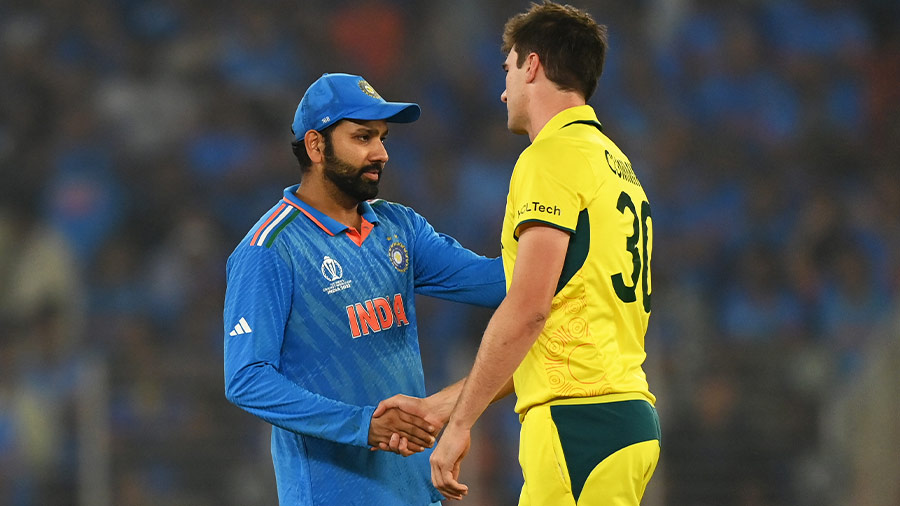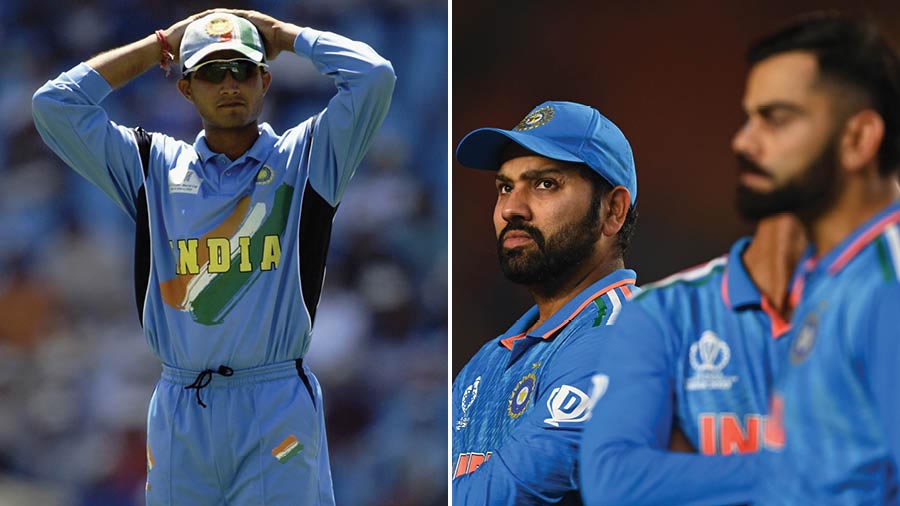Flying out to Ahmedabad from Kolkata on November 18, my anticipation for the World Cup final kicked in long before boarding my flight, as the Netaji Subhas Chandra International Airport was filled with former Australian players. Ricky Ponting, Matthew Hayden, Aaron Finch and Shane Watson were among those who were chatting over a drink in a lounge. Looking at these iconic Australian World Cup winners I wondered what would transpire if the current Australian team channelled their inner Pontings and Haydens in the final.
On the flight, the gentleman seated next to me had come down from San Francisco to watch the semis and the final. He has been attending the biggest World Cup knockout matches since 2015. Having seen India fall short on two occasions already, he was hoping it would be different this time around. The Sardar Vallabhbhai International Airport in Ahmedabad was a sight for sore eyes. Besides seeing the ex-Australian cricketers once more (including a trip to the washroom with Ricky Ponting), all the fliers were welcomed into the city by a troupe of dancers (accompanied by dhols). From the cab driver to the scooterist, Ahmedabad was buzzing with an energy I had rarely seen before.
With only three gates functioning as entry points, we were lucky to avoid a stampede
On the big day, I made my way from the hotel to the stadium at 11am, hoping to get there before the crowd started pouring in. It was a father-son trip for cricket’s biggest showpiece. Both my dad and I were excited about watching our first match in a stadium together and wanted to witness everything that would be on show. We got dropped off about two kilometres from our gate to find that the crowd had already started assembling in huge numbers. Chants of “India! India!” could be heard in full force, as a sea of blue emerged from all sides with painted faces and flags soaring high above their heads. Approaching the stadium, about 500m away from the gate, things got jam-packed. Nobody moved of their own free will. Rather, we were getting dragged forward in the collective push and pull of the crowd. With only three gates functioning as entry points, we were lucky to avoid a stampede altogether. Once inside the stadium complex, there were countless avenues leading to countless destinations. Overcoming momentary confusion, I was pleased to find my selection of seats from over two months ago to have been optimal for the occasion.
Before the national anthems took place, there was a jet show overhead with various small and large fighter planes in full flow, with the last act being the formation of a heart with an arrow through it. Was that an early sign of impending heartbreak? Nobody seemed to think so as the medley of voices reached a crescendo with more than one lakh people singing the national anthem. The noise remained fever-pitch as Rohit Sharma launched into Mitchell Starc and Josh Hazlewood, before being dismissed by a fabulous catch from Travis Head off the bowling of Glenn Maxwell.
The pitch invader we saw run towards Virat Kohli was the second one I had spotted on a cricket ground in four days. It was only when I got back to the hotel that I realised that the man had wrapped himself in pro-Palestinian slogans and images. Gradually, as the Indian batters found the pitch difficult to score on, the crowd also found it hard to find their voice. Cheers were few and far between with the boundaries even fewer. Realising India’s predicament, the crowd started applauding singles during the death overs. Rarely had I witnessed tailenders getting such a reception for rotating the strike! India finished on 240, one short of the score that had been enough four years ago at Lord’s to take the World Cup final to a super over.
The atmosphere at the stadium intensified as the mercury dipped and the lights took charge

The crowd in Ahmedabad got into the mood early on in the second innings, helped by Australia losing three early wickets Debrup Chaudhuri
The rush for food during the innings break was maddening. Even more maddening, though not surprising, was the absence of non-vegetarian options. I eventually settled for a vada pav, which, bizarrely, had the vada outside the pav. At least there were other vendors selling items in the stands, including chips, popcorn, ice cream, chaat and soft drinks. While it offered an impeded view on occasion, it also meant that a quick craving did not require me to move out of my seat.
The atmosphere at the stadium intensified as the mercury dipped and the lights took charge. Within no time, India’s fiery pace attack had picked up three wickets, with Kohli acting as cheerleader-in-chief. But the voices ebbed once more as Head and Marnus Labuschagne consolidated for Australia. The sense that this was not going to be India’s day had already been acknowledged by most present. With every boundary that Head smashed, the blue of the Indian support made way to reveal the orange of their seats. Thousands began to exit as the result appeared increasingly inevitable. With about 20 runs left to get for Australia, K.L. Rahul made a sharp stop behind the stumps, prompting someone behind me to cry out in disgust: “Haan, ab pakdo (yes, now you stop the runs)!” By then, Kohli, too, had started shaking his head.
Some genuine cricket lovers did take to their feet when Head got his well-deserved century, the seventh to do so in a men’s 50-over World Cup final. Sections of the stadium gave the southpaw a standing ovation as he left the scene of his spectacle with just two runs needed for victory. Once the match was officially over, the ground emptied out barring the stands in front of the winners’ dais. While the presentation arrangements were being made, there was a drone show that featured a stunning formation of the Indian map, before creating a moving image of the World cup trophy, complete with the word ‘Champions’. As the Australians celebrated a sixth world title, yellow lights glittered all around, with an AC/DC soundtrack for company.
A silence that must have felt like a symphony to Aussie ears

Rohit Sharma and Pat Cummins shake hands after leading their respective teams to memorable World Cup campaigns Getty Images
At the presentation ceremony, the crowd roared for Kohli as he picked up yet another player of the tournament award, but without winning the trophy he really wanted. As the umpires and match officials walked up to receive their medals, jeers started ringing as Ravi Shastri announced the name of Richard Kettleborough, the man who had officiated in several of India’s semi-final and final losses since 2013. The claps and the cheers returned as the Indian players received their runners-up medals. Rohit Sharma, dignified in defeat, got plenty of appreciation when he gave his final World Cup interview on the field. Among the Australian contingent, the most positive reactions from the crowd were reserved for Head, David Warner, Glenn Maxwell and Pat Cummins. However, many of the few that had remained till then turned around to make their way to the exit once Prime Minister Narendra Modi handed the World Cup trophy to Cummins, who proceeded to rejoice with his teammates.
When it comes to making the most of the big moments in big tournaments, Australia remain peerless. Whether overconfidence or complacency had crept into Team India or not, no Australian team can be taken for granted in a final. Winning is encoded into their cricketing fabric from the get-go, something we will do well to replicate. As for me, even though the final outcome was the exact opposite of what I desired, it was nonetheless an experience of a lifetime to witness cricket’s biggest game in the world’s largest cricket arena. As the night and the World Cup drew to a close, the silence at the Narendra Modi Stadium was deafening. Just as it had been during the key moments of the World Cup final. A silence that must have felt like a symphony to Aussie ears.


